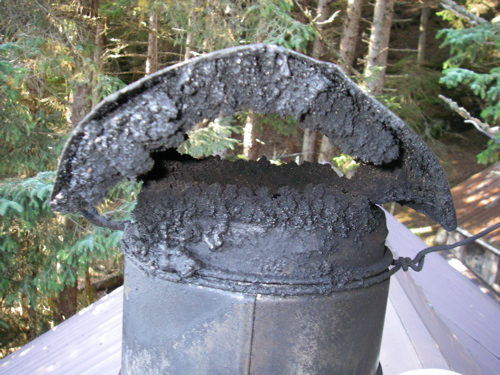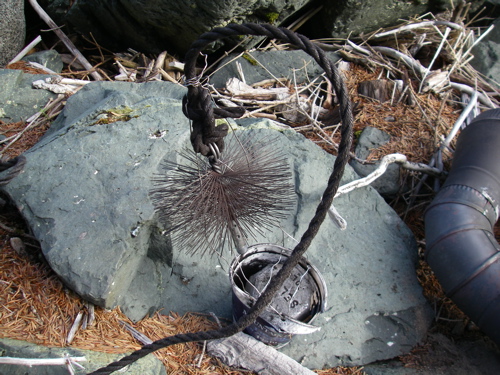Chimney sweeping is the most important preventative maintenance a wood stove user performs. Burning wood inevitably creates ash and creosote that congeals on the inside of the chimney as the hot combustion rises through the flue, creating a clogging, highly flammable coating that must be removed periodically. Chimneys should be cleaned at least once a year, preferably more often, particularly if you burn resinous soft woods, like we do.
Chimney cleaning is a tough, unpleasant job. This is why so many house fires are chimney fires—it’s just too easy to procrastinate; this is a deadly mistake, but one, I hate to admit, that we make often.
We cleaned our chimney at the beginning of October, for what appears to be the first time in two years. We did okay, thanks, I’m sure to burning the driest wood we can find, and regular applications of Red Devil Creosote Destroyer. Besides the safety factor, we were amply rewarded for our efforts in less tangible ways.
Covering the wood stove and a good area around it with drop cloths will keep soot from covering your home as you work.
The chimney sweep’s primary tool is a chimney brush, found at most hardware stores and wood stove shops. This mass of wire bristles is a nasty piece of work—handle it with care to avoid puncturing your skin or clothing!
The brush has a metal loop at one end, and a threaded shaft at the other. The shaft accommodates fiberglass rods that can be joined together to make a handle long enough to reach up through a chimney from below. This is great if you have a fireplace flue to clean, but it’s useless if you have a wood stove, particularly the more modern kind with baffles to recombust smoke before sending it up the flue. These rods could be used from above, but I can’t imagine trying to balance myself and some 20 feet of pole at the same time. I use a rope and weight.
I attach about 30 feet of line to the loop of the brush—enough to reach the bottom of our two-story length of chimney, plus enough extra to allow for leverage and mistakes. I attach a weight to the brush, hanging it through the brush and securing it to the loop at the top with baling wire. For a weight, I use a quart yogurt cup with holes punched below the rim for the wire. I put 3 small pigs of lead in the cup. I’m on the look out for a metal can of about this size to replace the cup, as one sweeping session beats the crap out of it.
I climb to the roof peak and clip my safety harness to a line that runs from a tree in the front yard, up over the roof peak. As a rule, I go no farther across the roof peak on the line side than to straddle the peak with one leg. My goal, should I fall, is to do so on the opposite side of the peak from the line, so it’ll save me, rather than come plunking down on my dazed head after I’ve hit the ground . . . .
I wear a respirator mask and goggles to protect me from the toxic creosote. Heavy gloves keep my hands clean, and safe from the bristles.
In practice, sweeping involves removing the chimney cap and lowering the brush into the chimney, working it up and down in short, sharp strokes to scrub the insides of the pipe. The soot and creosote loosens and falls into the wood stove below, where it burns in the next fire.
However, the baffles that provide a more complete burn prevent large amounts of ash to fall into the stove. If too much accumulates in the baffles, they’ll clog.
In the past, we removed the base plate that joins the chimney to the wood stove, and additional sections of pipe as needed. We then wrapped the mouth of a garbage bag over the exposed pipe end. As we brushed the inside of the pipe, the ash and creosote accumulated in the bag with very little mess.
This year, we learned that the base plate screws had fused. We could not disassemble our chimney for cleaning.
Luckily, we have a branch chimney for our wood fired water heater. This joins the main chimney at a T-joint. Chimney cleaning includes removing the branch for brushing outside, so we can use the T-joint as an inspection port. We built a funnel out of cardboard to be inserted in the hole of the T. This caught the majority of soot coming down the chimney, preventing it from falling into the baffles.
I also left the yogurt cup, which holds my brush weights, open. This catches much of what I brushed off the chimney, to be pulled out and dumped. This accounted for almost all of the soot up to the bottom of the T-joint. We swept everything below it, about 4 feet of pipe, into the baffles.
Once we’d finished, we needed to find out if the draft had been clogged by the remaining soot. To do this, we lit a cone of incense and set it inside the wood stove. We watched through the open T-joint for smoke. If we didn’t see any, no matter, as the cabin fills with that much smoke anyway if we burn an incense cone.
We not only saw the smoke, but the area outside the cabin became fragrant with incense. We had not clogged the draw.
To complete the job, we cleaned the chimney cap with a wire brush, and reattached it.
About every third fire, we throw in a couple of tablespoons of Red Devil Creosote Destroyer. We know this stuff works well, as inspecting the chimney showed that very little creosote had accumulated. Most of what needed to be cleaned was soft, black ash. Regular applications through the burning season will make sure this big job is easy again next year.



This made me wonder about a retrofit system for gasification, but apparently nobody makes such a kit. There are wood-gas stoves, but they all appear to be for camping.
If I still had the old cast-iron stove we had when I was a kid, I’d try to make such a thing, but I don’t. Have you considered a Franklin stove? They are much more efficient than the more traditional cast-iron stoves (which I think I remember seeing in some of your pics).
Either of these two solutions would reduce the soot and creosote build up by quite a bit (of course, I’m not sure if anything can completely git rid of creosote since you’re burning Pine, which is a high-tar wood).
Any way, just my inner nerd trying to solve an interesting problem :^).
Hi Don,
I’ve never heard of a wood-gas hybrid. A lot of people around here use oil stoves, which seem popular, but, of course, make no sense for the way we live.
Other than anything manufactured under the specific patent or brand name of Franklin stove (which I assume exists) I believe that all wood stoves are Franklin stoves. As I understand it, Franklin invented the wood stove as an improvement over the fireplace. Our wood stove, a Waterford Ashling, is about as advanced as you can get short of a catalytic (which I avoid because it needs to be replaced fairly often). It’s extremely efficient, but no stove can compete with our burning soft, resinous woods, or our procrastination. Chimney cleaning is just another chore we’re required to perform to live the life we choose.
Mark,
first picture got me so scared and I couldn’t believe you didn’t have problems. That chimney cap is loaded beyond recognition. 🙁
We have used wood stoves all my life. We always clean twice a year and your brush looks a lot like ours. However, no matter how clean you keep your pipe crap happens.
It will be 2 years ago Jan 5 when we lost our home to a fire. After the fire, we located the chimney pipe, transfer box, etc. the fire chief and I tried to figure out why it happened. The pipe was solid and no wear or burnouts and the transfer box was solid. He summized that the reason for the fire was the pipe was to close to the floor joist and over time the heat finally caught the wood on fire.
It was hell living homeless for about a year but finally we moved into our old/new home 1 year ago. We purchased another wood stove and we are using the heck out of it. Lots of friends question why would would use wood heat after what we went through. Well, why wouldn’t we? I’ve never lived in a home without wood heat until we lost our home. Our entire family hated it and we all said, our new home will have another wood stove.
However, we now have our 4th wood stove and we went back to old reliable, blaze king. These stoves are supreme out here and they are made about 100 miles from our home. Although Franklin invented the wood stove, not sure I would call all wood stoves a franklin but I do see your point. We do call other wood stoves either BKing or nothing. 🙂
Thanks for your post and thanks for letting me rant.
Bob